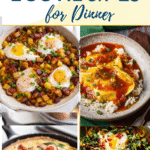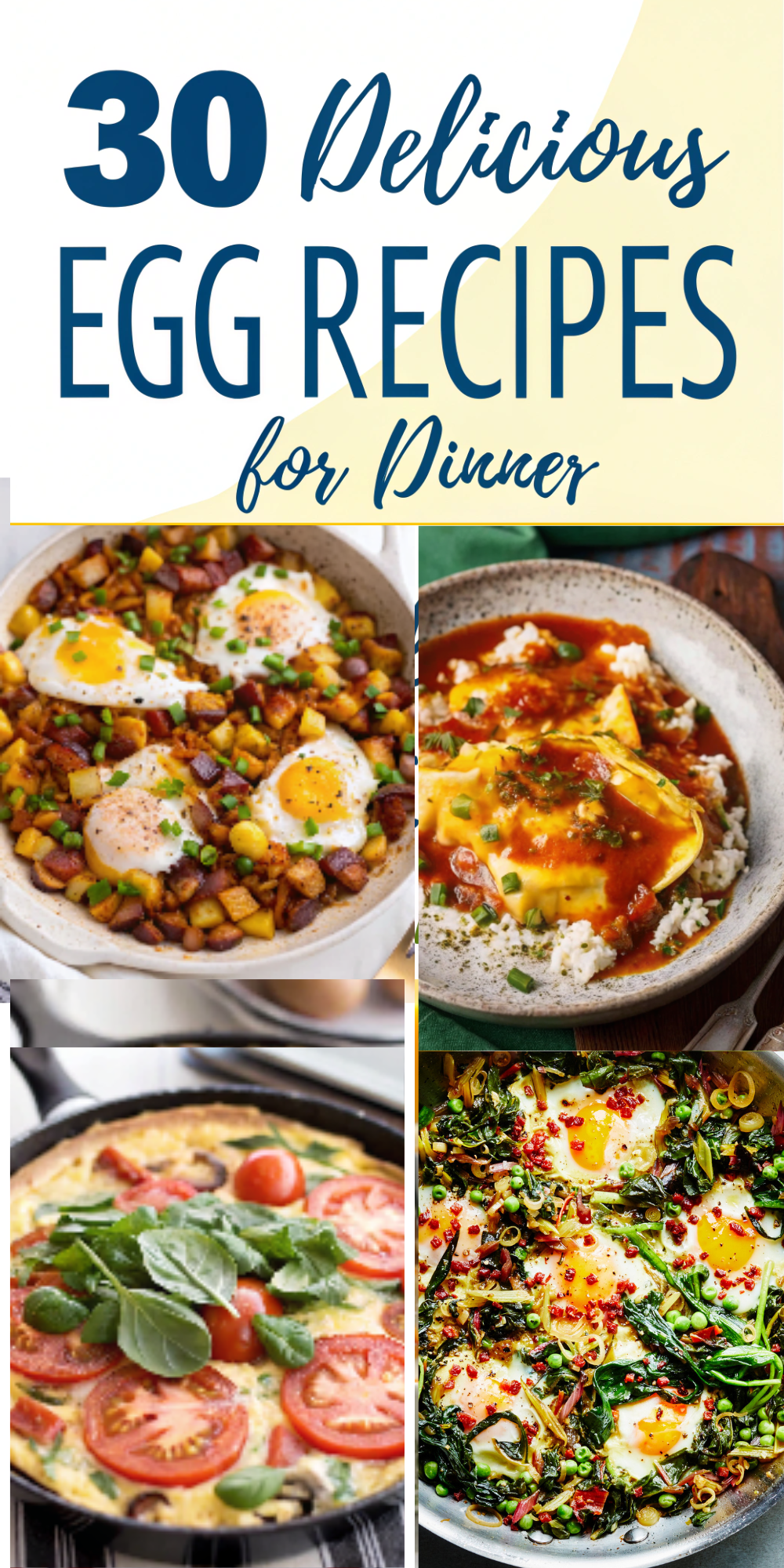Share via:
Pasta is a versatile and satisfying meal that fits well into a vegetarian lifestyle. Whether you’re looking for a quick dinner or something a bit more special, there are countless ways to prepare vegetarian pasta that deliver excellent flavor and nutrition.
I’ve gathered the 10 best vegetarian pasta recipes that balance simplicity, taste, and creativity to help expand your meal options.
These recipes cover a range of styles, from comforting baked dishes to fresh, light options, making it easier to enjoy pasta without meat while keeping your meals interesting.
1) Creamy Mushroom and Spinach Fettuccine
I enjoy this creamy mushroom and spinach fettuccine for its simple preparation and balanced flavors. It’s a quick vegetarian pasta that fits well into busy evenings while offering a satisfying, comforting dish.
The mix of earthy mushrooms and fresh spinach in a garlic cream sauce is straightforward but effective.
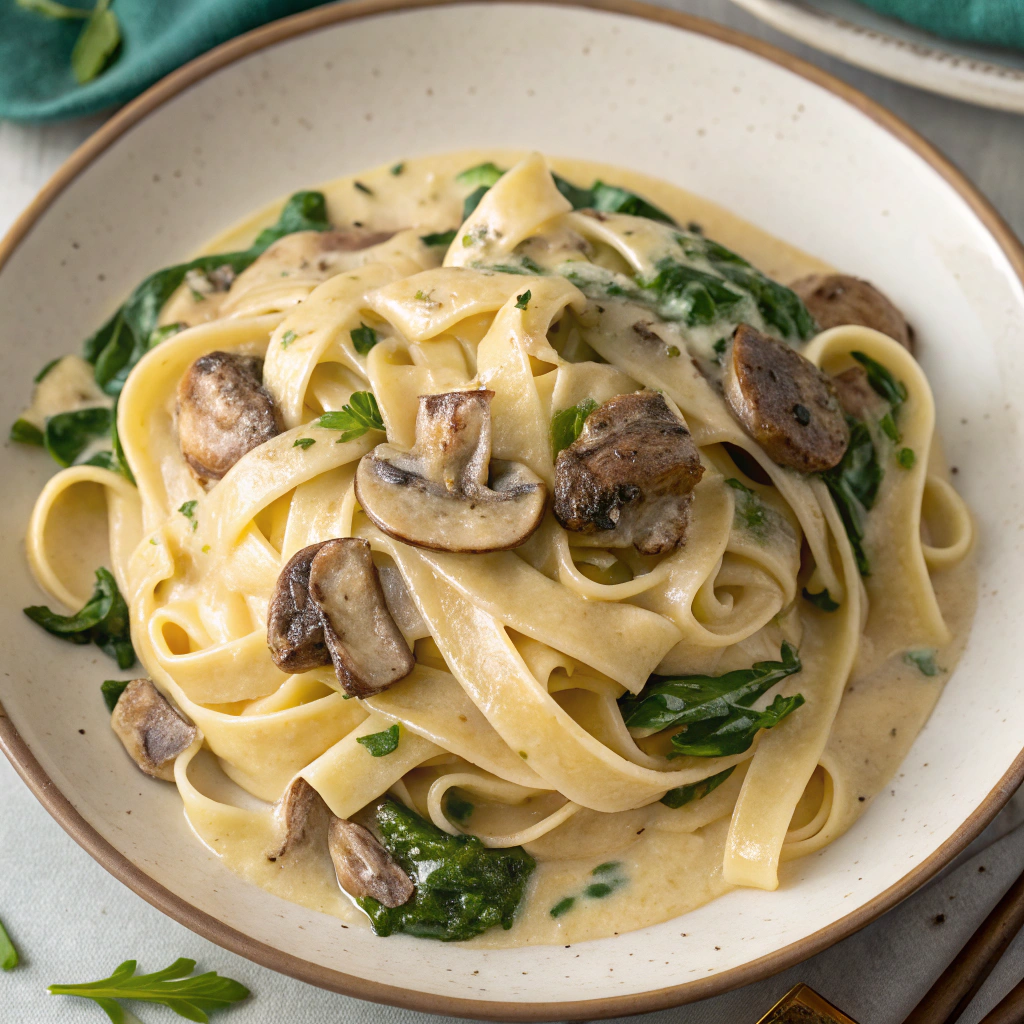
Ingredients
- 8 oz fettuccine pasta
- 2 cups fresh spinach
- 2 cups mushrooms, sliced
- 3 cloves garlic, minced
- 1 cup heavy cream or plant-based cream
- 1/2 cup grated Parmesan or vegan cheese
- 2 tbsp olive oil
- Salt and pepper to taste
Steps
- Cook the fettuccine according to package instructions until al dente. Drain and set aside.
- Heat olive oil in a large skillet over medium heat. Add garlic and sauté until fragrant.
- Add mushrooms and cook until they release moisture and soften.
- Stir in the fresh spinach and cook until wilted.
- Pour in the cream and let it simmer for a few minutes to thicken slightly.
- Mix in the Parmesan or vegan cheese until melted and absorbed into the sauce.
- Toss the cooked fettuccine into the sauce. Season with salt and pepper. Serve immediately.
2) One-Pot Tomato Basil Pasta
One-pot tomato basil pasta is a simple, straightforward meal I rely on for busy days. It combines fresh tomatoes, basil, and pasta in one pot, minimizing cleanup.
The process is quick and requires common ingredients, making it easy to prepare even on a weeknight.
Ingredients
- 12 oz pasta (such as linguine or spaghetti)
- 1 can (14 oz) diced tomatoes or fresh tomatoes
- 4 cups vegetable broth
- 1 small onion, thinly sliced
- 3 cloves garlic, minced
- 1 cup fresh basil leaves, chopped
- 2 tbsp olive oil
- 1/2 tsp red pepper flakes (optional)
- Salt and pepper to taste
- Grated Parmesan or vegan cheese (optional)
Steps
I start by placing pasta, tomatoes, onion, garlic, and basil in a large pot. I pour in the vegetable broth and drizzle olive oil on top.
Then I bring the pot to a boil, cover it, and reduce the heat to a low simmer. I stir every couple of minutes to prevent sticking.
After about 10 minutes, I check the pasta. Once most of the liquid has evaporated but some remains to coat the noodles, I turn off the heat.
Finally, I season with salt, pepper, and red pepper flakes if I want some heat. I stir in cheese if using and serve immediately.
3) Baked Ziti with Ricotta and Mozzarella
Baked ziti with ricotta and mozzarella is a simple yet satisfying vegetarian pasta dish. I like how the creamy ricotta balances the tangy marinara sauce.
The melted mozzarella adds a gooey texture that makes this classic Italian-American recipe comforting without any meat.
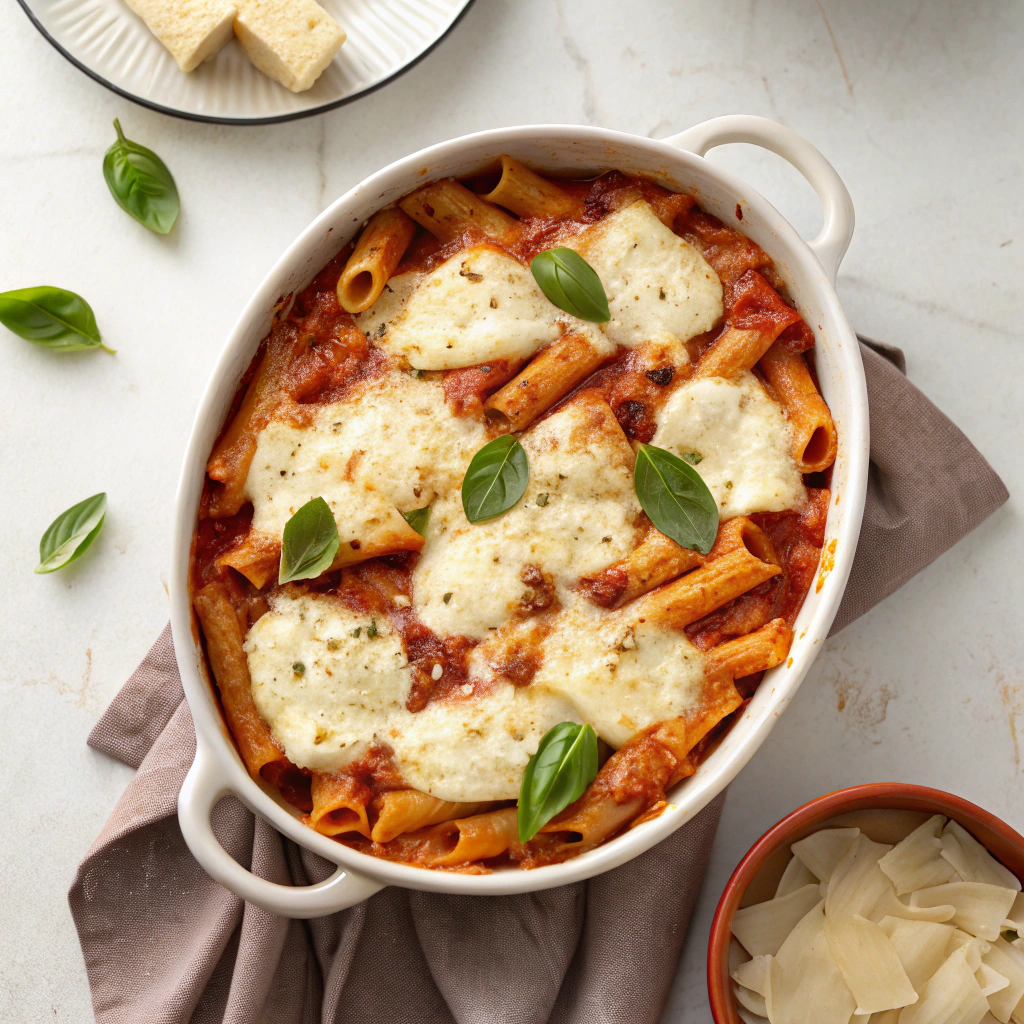
Ingredients
- 1 pound ziti pasta
- 2 cups ricotta cheese
- 3 cups marinara sauce
- 2 cups shredded mozzarella cheese
- ½ cup grated Parmesan cheese
- 1 teaspoon dried Italian herbs
- Salt and pepper to taste
- Olive oil for greasing
Steps
- Preheat the oven to 375°F (190°C).
- Cook the ziti pasta according to package instructions until al dente. Drain.
- In a large bowl, combine the ricotta cheese, Italian herbs, salt, and pepper.
- Toss the cooked pasta with the marinara sauce and half of the mozzarella cheese.
- Layer half the pasta mixture in a greased baking dish. Dollop half the ricotta mixture on top.
- Repeat the layers, then sprinkle the remaining mozzarella and Parmesan cheese over the top.
- Cover with foil and bake for 25 minutes. Remove foil and bake for another 10-15 minutes until bubbly and golden.
- Let it rest for 5 minutes before serving.
4) Penne alla Vodka with Vegan Cashew Cream
Penne alla Vodka is a classic pasta dish that gets a vegan update by using cashew cream instead of dairy. The sauce combines tomato, vodka, and cashew cream for a smooth, rich texture. This recipe is straightforward and ideal for those who want a creamy pasta without animal products.
Ingredients
- 8 oz penne pasta (gluten-free if needed)
- 1 cup raw cashews, soaked for at least 4 hours
- 1 cup water (for blending cashews)
- 2 cups canned crushed tomatoes
- 1 small onion, finely chopped
- 3 garlic cloves, minced
- 1/4 cup vodka
- 2 tbsp olive oil
- 1 tsp dried oregano
- Salt and pepper to taste
Steps
Drain the soaked cashews and blend with 1 cup of water until completely smooth. Set aside the cashew cream.
Cook the penne according to package directions until al dente. Reserve 1 cup of pasta water before draining.
Heat olive oil in a pan and sauté onion and garlic until soft. Add crushed tomatoes and oregano, cooking for about 10 minutes.
Carefully add vodka to the tomato sauce and simmer for 5 minutes to reduce alcohol content.
Stir in the cashew cream and mix well. Add reserved pasta water gradually until the sauce reaches your desired creaminess.
Combine cooked pasta with the sauce. Adjust seasoning with salt and pepper. Serve warm.
5) Chickpea and Spinach Spaghetti
I like this chickpea and spinach spaghetti for its balance of protein, greens, and carbs. It’s simple to make and ready in under 30 minutes.
The dish blends sautéed chickpeas with fresh spinach and pasta for a nutritious, satisfying meal.
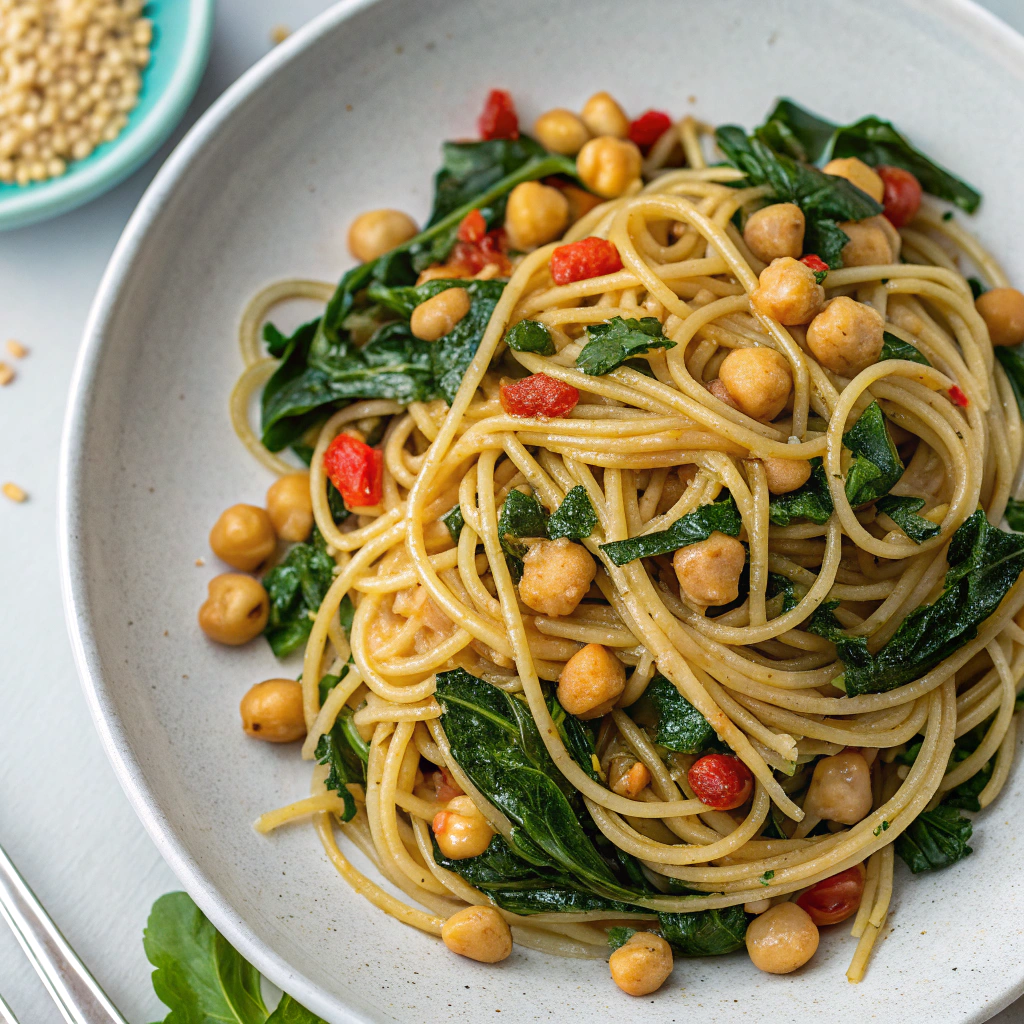
Ingredients
- 8 oz spaghetti
- 1 can chickpeas, drained and rinsed
- 3 cups fresh spinach
- 3 cloves garlic, minced
- 2 tbsp olive oil
- 1/4 tsp red pepper flakes (optional)
- Salt and pepper to taste
- Grated Pecorino or Parmesan cheese (optional)
- Juice of half a lemon
Steps
- Cook the spaghetti according to package instructions. Drain and set aside.
- Heat olive oil in a large pan over medium heat. Add garlic and red pepper flakes, sauté for 1 minute.
- Add chickpeas and cook until slightly crispy, about 5-7 minutes. Season with salt and pepper.
- Stir in fresh spinach and cook until wilted, about 2 minutes.
- Toss cooked spaghetti with the chickpea and spinach mixture. Add lemon juice and cheese if using.
- Serve warm with extra cheese on top if desired.
6) Butternut Squash Ravioli with Sage Butter
Butternut squash ravioli is a simple, comforting dish with subtle sweetness and savory notes. I enjoy using sage butter to enhance its flavor without overpowering the filling.
It works well whether you make the pasta dough from scratch or use wonton wrappers as a shortcut.
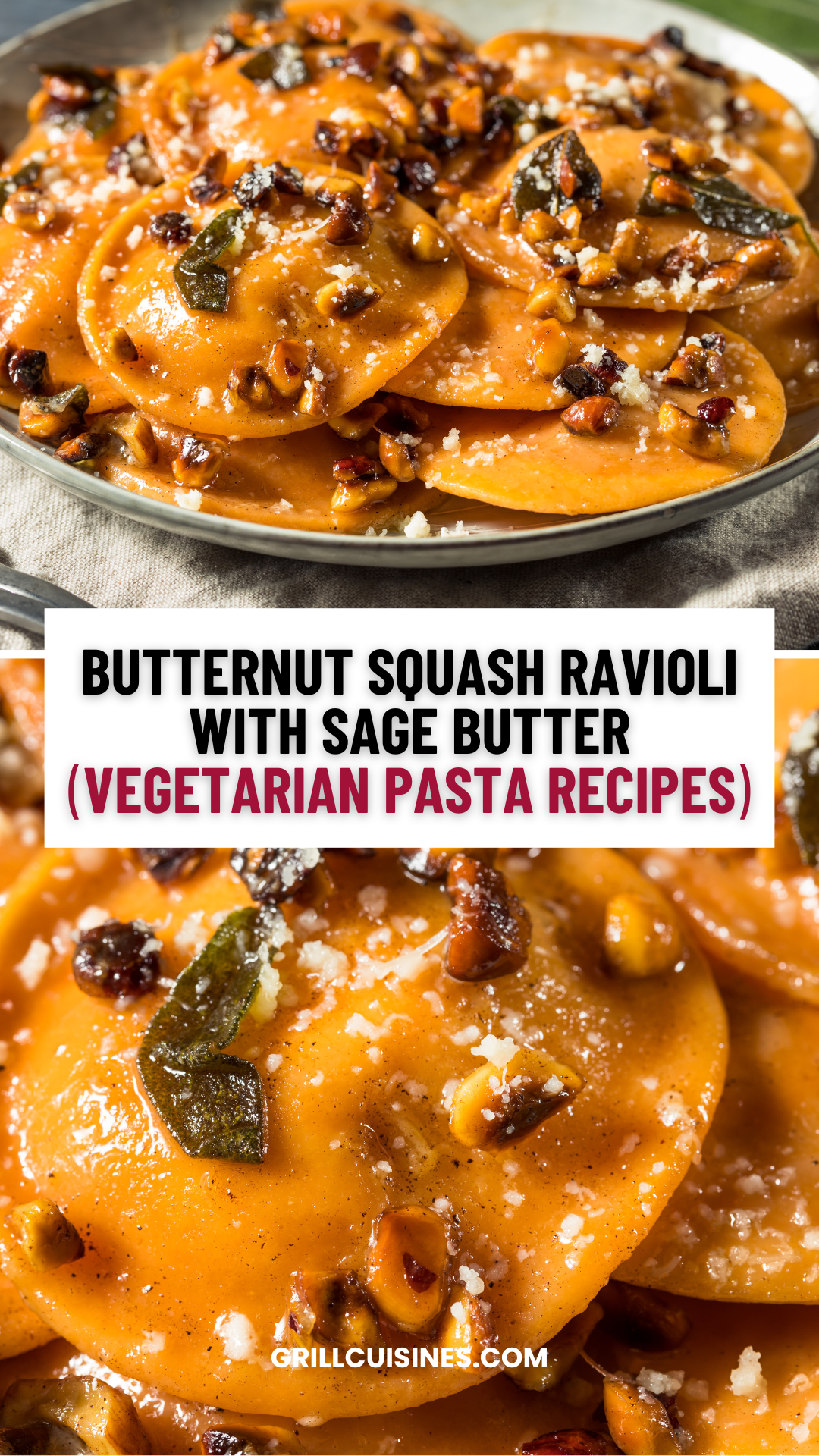
Ingredients
- 1 small butternut squash, roasted and mashed
- 1/2 cup ricotta or goat cheese
- 1/4 tsp nutmeg
- Salt and pepper, to taste
- Fresh pasta dough or wonton wrappers
- 6 tbsp butter
- 1 tbsp fresh sage, chopped
Steps
- Roast the butternut squash until tender, then mash it in a bowl.
- Mix the squash with cheese, nutmeg, salt, and pepper until combined.
- Roll out your pasta dough or prepare wonton wrappers for filling.
- Spoon a small amount of the filling onto each wrapper, fold, and seal the edges.
- Boil ravioli in salted water until they float, about 3-4 minutes.
- While cooking, melt butter in a pan and add chopped sage to infuse.
- Toss drained ravioli in the sage butter sauce and serve immediately.
7) Classic Cheese Tortellini with Pesto
I turn to cheese tortellini with pesto when I want a simple, flavorful vegetarian pasta that comes together quickly.
The combination of pillowy cheese-filled pasta and fresh basil pesto never fails to satisfy. It’s a straightforward dish perfect for busy weeknights or a casual dinner.
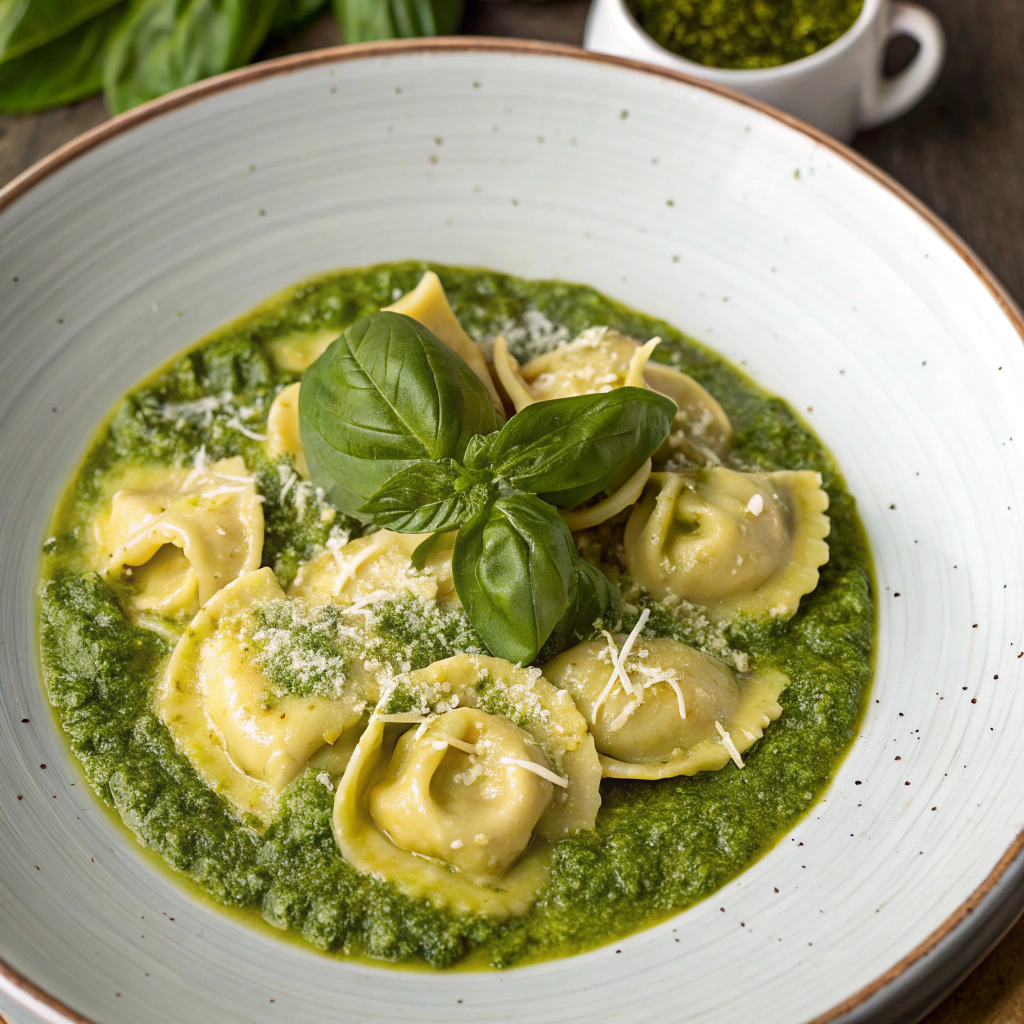
Ingredients:
- 1 package cheese tortellini (fresh or frozen)
- 1 cup basil pesto (store-bought or homemade)
- ½ cup grated Parmesan cheese
- 1 cup roasted vegetables (optional)
- Salt and pepper, to taste
- Fresh basil leaves for garnish
Steps:
- Cook the tortellini according to package directions, then drain.
- Toss the hot tortellini with basil pesto until well coated.
- Add roasted vegetables if you like, and season with salt and pepper.
- Transfer to a serving bowl and sprinkle Parmesan cheese on top.
- Garnish with fresh basil leaves before serving.
8) Roasted Vegetable Lasagna
I like roasted vegetable lasagna for its balance of flavor and texture. Roasting the vegetables reduces moisture, preventing a soggy dish.
The layers of roasted zucchini, bell peppers, and onions, combined with cheese and tomato sauce, create a satisfying meal.
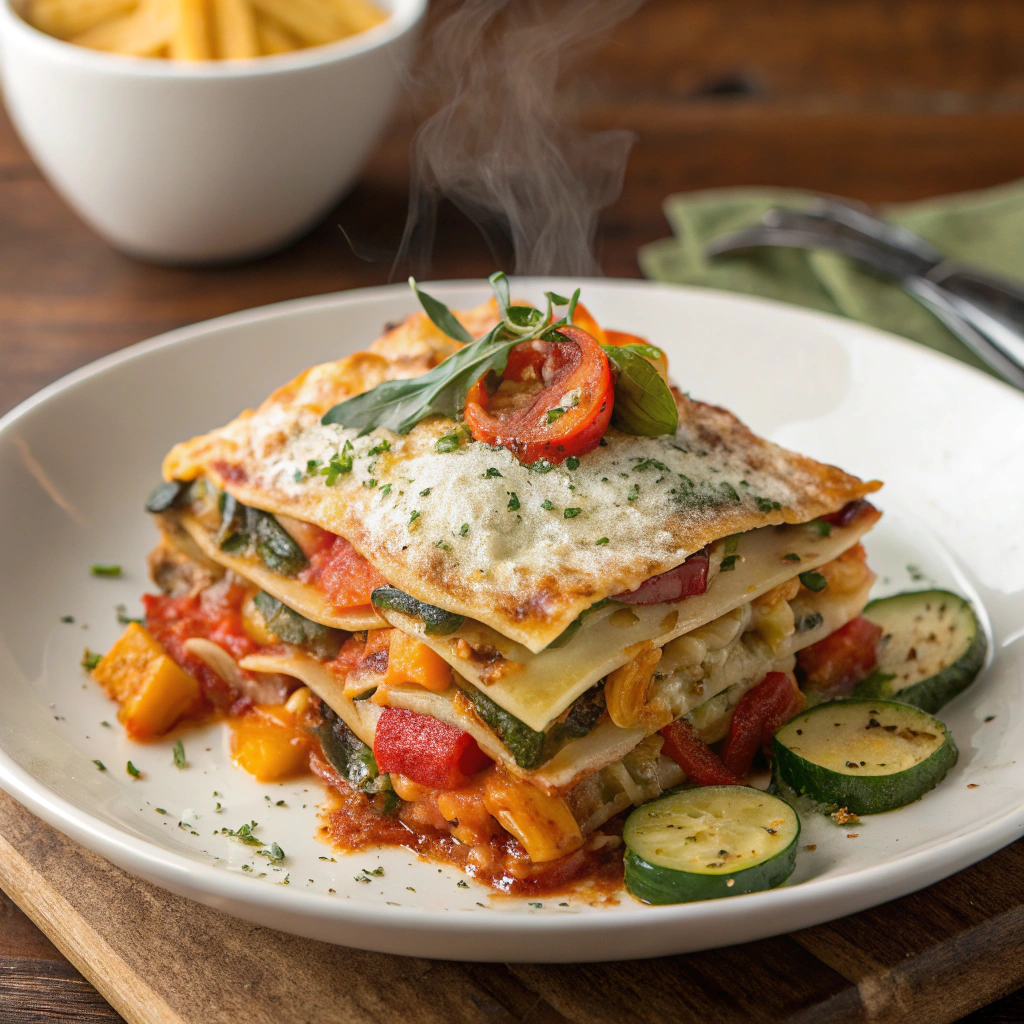
Ingredients
- 2 medium zucchini, sliced
- 1 red bell pepper, sliced
- 1 onion, sliced
- 2 cups marinara sauce
- 1 ½ cups ricotta cheese
- 1 cup shredded mozzarella
- ½ cup grated Parmesan
- 9 lasagna noodles, no-boil or cooked
- 2 tbsp olive oil
- Salt and pepper to taste
Steps
Preheat the oven to 400°F (200°C). Toss the zucchini, bell pepper, and onion with olive oil, salt, and pepper. Roast the vegetables for 20-25 minutes until tender.
Spread a thin layer of marinara sauce on the bottom of a baking dish. Layer 3 noodles, half the roasted vegetables, half the ricotta, a third of the mozzarella, and some marinara. Repeat the layers.
Top the final layer of noodles with remaining marinara, mozzarella, and Parmesan. Cover with foil and bake for 30 minutes. Remove the foil and bake another 10 minutes until cheese is golden.
Let the lasagna rest for 10 minutes before serving. This dish keeps well and flavors meld after sitting.
9) Lemon Garlic Broccoli Pasta
Lemon Garlic Broccoli Pasta is a simple, flavorful dish that you can make quickly. It combines fresh broccoli, garlic, and lemon to create a light yet satisfying pasta meal.
I enjoy this recipe for its clean taste and minimal preparation.
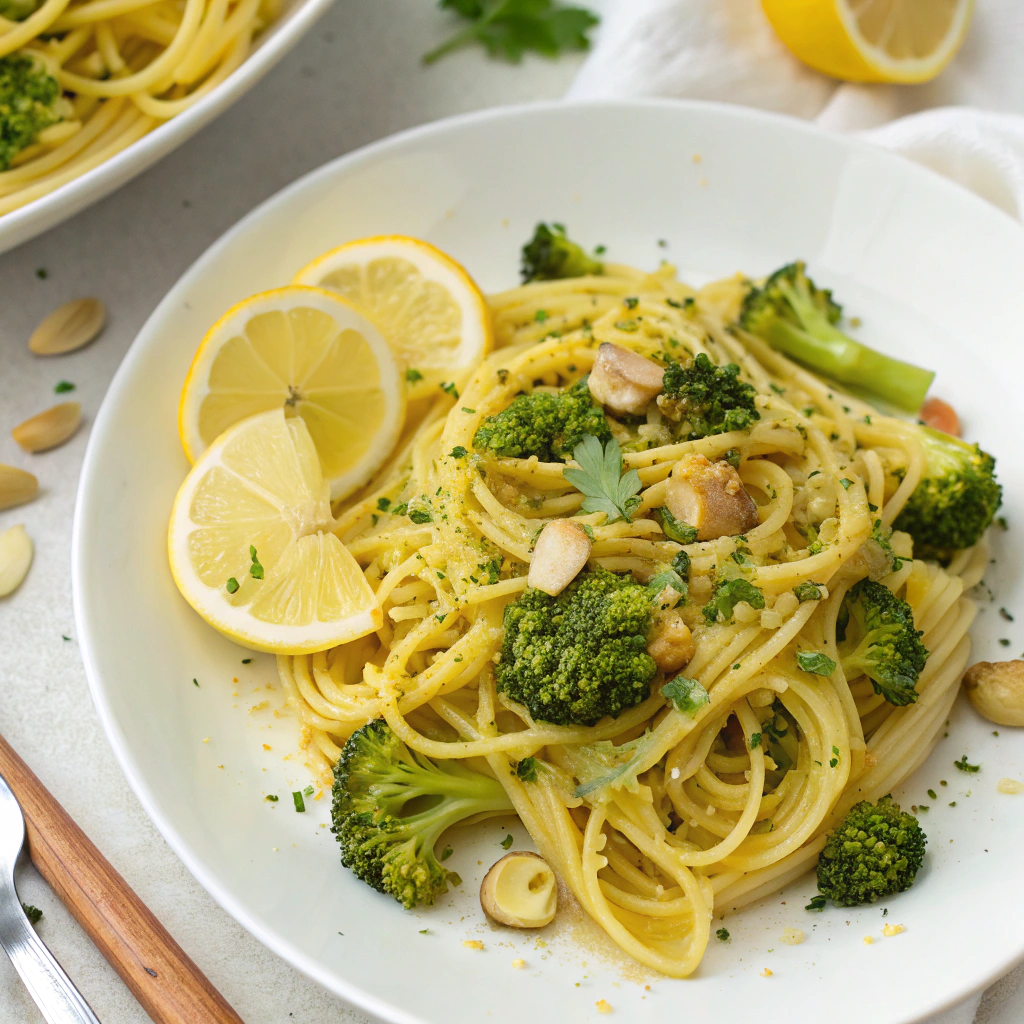
Ingredients
- 8 oz pasta (penne or rotini recommended)
- 2 cups broccoli florets
- 3 cloves garlic, minced
- 2 tablespoons olive oil
- Juice and zest of 1 lemon
- Salt and pepper to taste
- ¼ cup grated Parmesan cheese (optional)
Steps
- Cook pasta according to package instructions until al dente. Add broccoli florets during the last 3 minutes of cooking, then drain.
- Heat olive oil in a pan over medium heat. Add minced garlic and sauté until fragrant, about 1 minute.
- Toss the cooked pasta and broccoli in the pan with garlic oil. Add lemon juice, zest, salt, and pepper. Stir to combine.
- Serve topped with Parmesan cheese if desired. Adjust seasoning before serving.
10) Eggplant and Tomato Ragù with Orecchiette
I enjoy this eggplant and tomato ragù with orecchiette for its balance of textures and flavors. The roasted eggplant softens into the rich tomato sauce, creating a hearty vegetarian ragù.
The small, cup-shaped orecchiette pasta holds the sauce well, making each bite satisfying.
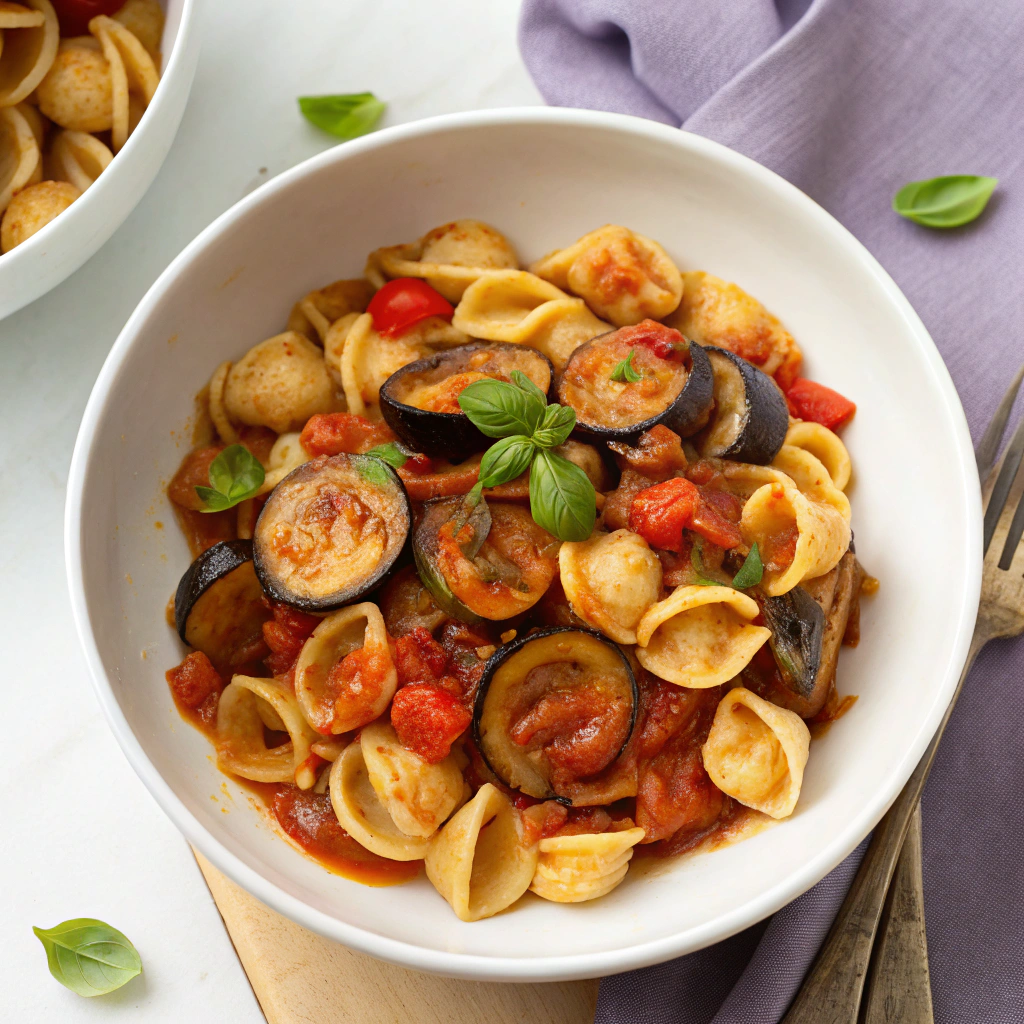
Ingredients
- 2 medium eggplants, diced
- 3 tablespoons olive oil
- 1 onion, finely chopped
- 3 garlic cloves, minced
- 1 can (14 oz) crushed tomatoes
- 1/2 cup vegetable broth
- 1 teaspoon dried oregano
- Salt and pepper to taste
- 300g orecchiette pasta
- Fresh basil leaves, for garnish
Steps
- Preheat the oven to 400°F (200°C). Toss the diced eggplant with 1 tablespoon olive oil and roast for 20 minutes, stirring halfway.
- Meanwhile, heat 2 tablespoons olive oil in a pan over medium heat. Add onion and garlic; cook until soft.
- Stir in the crushed tomatoes, vegetable broth, oregano, salt, and pepper. Simmer for 15 minutes.
- Add the roasted eggplant to the sauce and cook for 5 more minutes to combine flavors.
- Cook the orecchiette pasta according to package instructions. Drain and toss with the ragù.
- Serve garnished with fresh basil.
Health Benefits of Vegetarian Pasta
Vegetarian pasta dishes often combine a range of plant-based ingredients that enhance both taste and nutrition.
These meals provide essential nutrients while supporting healthy body weight through balanced energy and fiber content.
Nutritional Highlights
Vegetarian pasta typically includes vegetables, legumes, whole grains, and sometimes nuts or seeds. This mix offers a rich supply of fiber, vitamins, and minerals like folate, magnesium, and potassium. Fiber improves digestion and promotes steady blood sugar levels.
Many recipes use tomato-based sauces rich in antioxidants such as lycopene, which supports heart health. Protein sources like lentils or beans can be added to create a complete amino acid profile, especially important in vegetarian diets.
I find that the diverse ingredients in these dishes provide sustained energy and help fulfill daily nutrient requirements without excess fat or cholesterol.
Weight Management Support
Vegetarian pasta supports weight control primarily through its high fiber content and low-calorie density. Fiber increases satiety, meaning I feel fuller longer, which reduces the likelihood of overeating.
Choosing whole-grain pasta instead of refined versions further helps by providing slower-digesting carbohydrates that prevent blood sugar spikes. Combined with vegetables, the meals tend to be nutrient-rich but not calorie-dense.
Plant-based protein in these recipes also maintains muscle mass during weight loss or maintenance. I rely on these balanced pasta meals as effective options to manage my weight without sacrificing flavor or satisfaction.
Tips for Cooking Perfect Vegetarian Pasta
Getting the pasta right begins with choosing the proper type and quality. Then, it’s about creating a balance between flavors and textures that keep the dish engaging and satisfying.
Selecting the Right Pasta
I always start by matching the pasta shape to the sauce and vegetables I plan to use. For thick, creamy sauces, I prefer wide noodles like fettuccine or pappardelle because they hold sauce well. For lighter, chunky tomato-based dishes, tube-shaped pastas like penne or rigatoni trap bits of vegetables perfectly.
Using high-quality durum wheat pasta makes a big difference in texture. I cook it until al dente, which means firm to the bite but fully cooked. Overcooked pasta loses structure and makes the dish mushy.
Fresh pasta works well for delicate sauces but dries faster and needs gentler handling. Dry pasta lasts longer and is usually better for hearty, sauce-heavy recipes.
Balancing Flavors and Textures
I focus on layering distinct tastes and textures in every dish. For example, combining soft, cooked vegetables with crunchy nuts or fresh herbs adds contrast. Acidic ingredients like lemon juice or vinegar brighten the flavor and prevent heaviness.
Using umami-rich elements like mushrooms, sun-dried tomatoes, or aged cheese deepens the savory profile without meat. Salting cooking water adequately is essential to season the pasta itself. I taste frequently and adjust seasoning throughout the cooking process.
Incorporating fresh herbs at the end preserves their brightness. I also add a splash of olive oil to finish for smoothness and to carry the flavors throughout each bite.
I am a writer, editor, and publisher of Grillcuisines.com – an online blog dedicated to sharing grilling tips, accessories, and recipes to encourage more people to get outside and grill.
I’m off to find out the different types of grill foods, their seasons, and how to conduct outdoor cooking properly. I’ll also show you some of my grill-worthy cooking tools & accessories!



